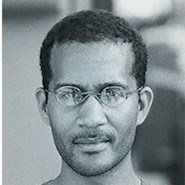By T.R. Witcher
When it was completed in 1869, the 475 ft long Waco Suspension Bridge was the first major suspension bridge in Texas, according to the Historic American Engineering Record. The bridge, which crossed the Brazos River and became a crucial link in the Chisholm Trail, connected Texas cattle ranchers to trains in Kansas and helped establish the fortunes of Waco, a city established in 1849.
Designed by engineer Thomas M. Griffith, with steel cables provided by the John A. Roebling's Sons Co. — future builders of the Brooklyn Bridge — the Waco bridge “originally featured two castellated pink brick towers,” and its tollhouses featured “stepped gable roofs, parapets, and round arched openings,” according to HAER. It was a beefy looking bridge, wide enough to handle cattle, stagecoaches, and pedestrians.
It originally opened as a toll bridge in 1870 but was purchased by McLennan County in 1889, sold to the city of Waco for $1, and converted to a free bridge.
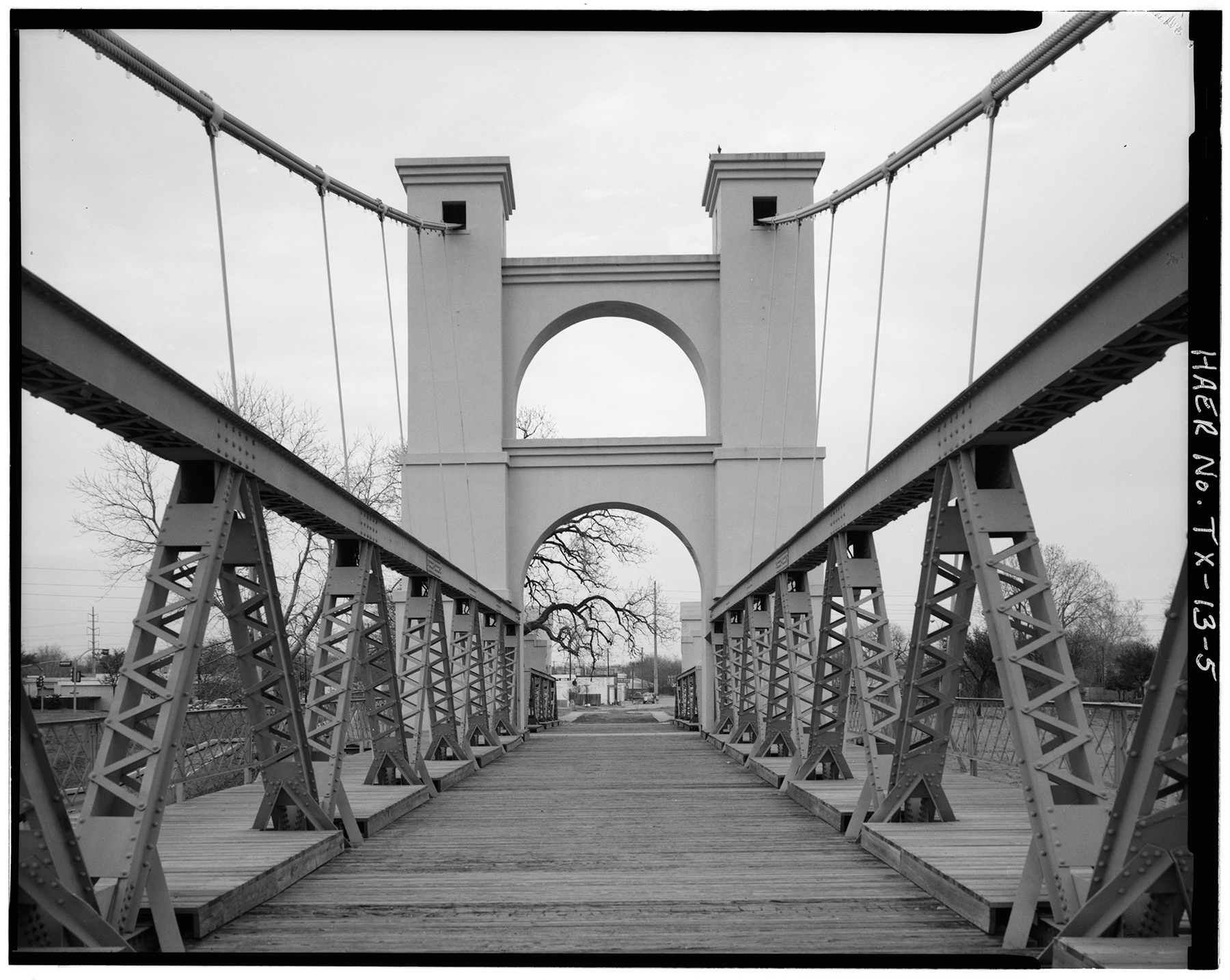
The bridge was extensively modified in 1914 to handle more traffic. According to an article on the website of the Texas State Historical Association, “The cable system was replaced, the roadway was reinforced with steel, and the towers were rebuilt and stuccoed.” Stiffening trusses were also added.
Vehicles used the bridge until 1971, when it was converted to pedestrian use. The prior year the bridge was listed on the National Register of Historic Places.
Removing the suspension cables
These days, the Waco Suspension Bridge anchors a network of parks in the center of Waco that hosts sporting events, concerts, and weddings. But in recent years, the cabling and anchors were approaching the ends of their service lives, so the city of Waco, starting in fall 2020, embarked on a $12.4 million renovation of the bridge to replace the cables and road deck and install a new anchorage system.
The rehabilitation of the bridge was motivated by the findings of the 2017 comprehensive evaluation report by Sparks Engineering, Inc., a San Antonio-based consultant specializing in existing structures. The evaluation involved nondestructive testing, metallurgy, ground-penetrating radar, a geometric survey, and detailed inspection of all structural elements. According to Patrick Sparks, P.E., president of the firm “The bridge was nearing the end of its useful life, primarily because of degradation of the 1914 cables and anchor rods. The bridge had lost almost 20% of its live load capacity. The City of Waco acted quickly and we moved forward with a complete rehabilitation design. We gave it 10 more years.”
The city hired Sparks Engineering in 2018 as the engineer of record to design the project. In 2019, Balch Springs, Texas-based contractor Gibson & Associates Inc. won the bid to construct the renovation. Gibson subcontracted Structural Technologies to remove and replace the suspension system. Structural Technologies subcontracted Modjeski and Masters, a Mechanicsburg, Pennsylvania-based bridge design firm, to perform the erection engineering for the removal of the existing suspension system and installation of the new suspension system.
Work began in fall 2020. Gibson designed and installed a temporary foundation of steel casings with steel bent caps in the river to take the load of the bridge while the suspension cables were removed. This temporary system also supported a work platform built beneath the bridge deck, which allowed workers efficient and safe access to the main span. Sparks Engineering required these mid-river supports to make it possible to remove the existing suspension cables. (The platform and the support piers will be removed when the project is completed.)
“During construction it's no longer a suspension bridge; it's actually just a truss bridge on temporary supports,” says Tim Stuffle, P.E., a senior engineer at Modjeski and Masters. “It gives a lot of leeway to replace the components in their more or less original location.”
For the engineers, understanding the bridge’s geometry was crucial to manufacturing new components to the right lengths. Although they had the design plans from the bridge’s reconstruction in 1914, Modjeski requested a survey of the existing structure to see whether settlement, movement, or other factors had changed its geometry versus the original plans. “We had to be able to really understand what we had to work with to make sure new components would fit correctly,” says Stuffle.
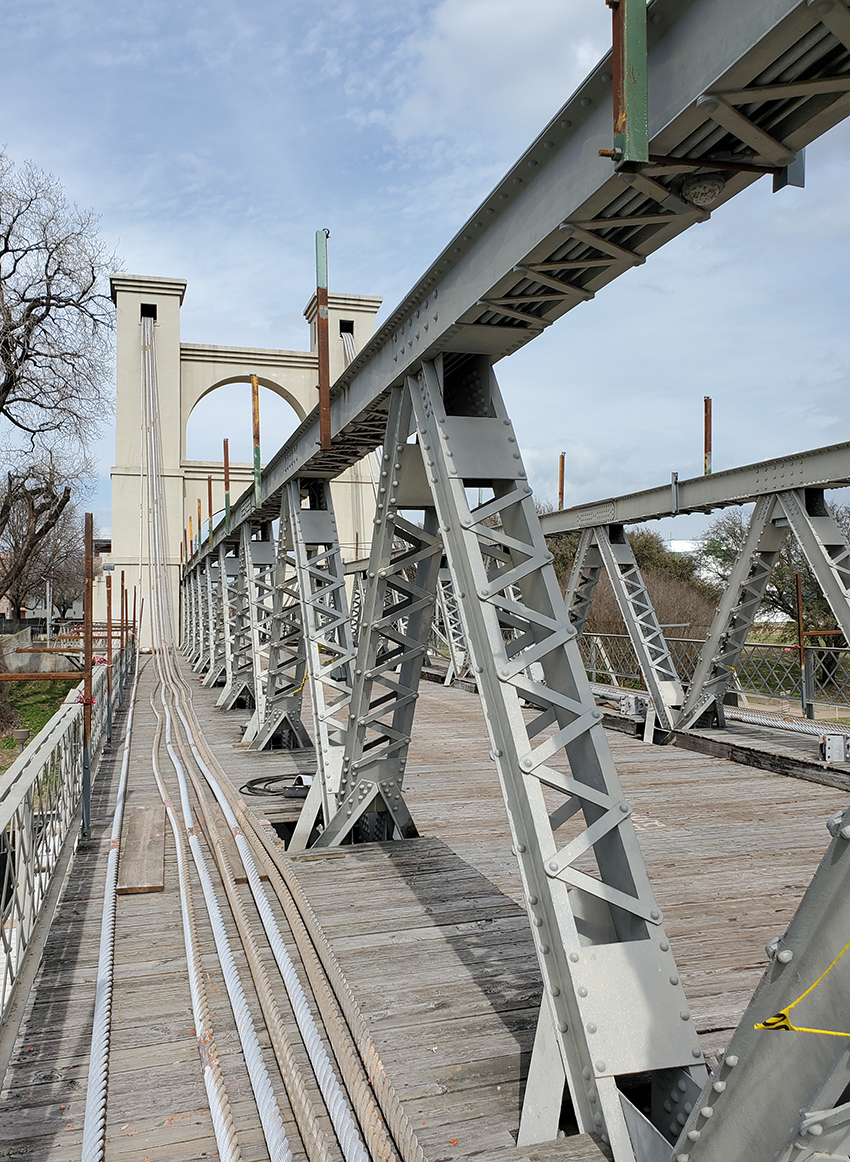
The geometry, it turned out, was substantially different from what they expected. One tower was several inches shorter than the other and the sag of the cables was also about 18 in. more than expected. In addition, the stiffening trusses were a little flatter and didn't have as much rise as the original plan called for. The height of the two main cables also varied by about 5 in. at mid-span.
Also of concern was the midspan hinge in the stiffening truss, which had some damage that had been repaired in the 1940s. Contractors were worried about whether the hinge could take the articulation necessary to return it to the original rise profile called for in the 1914 plan. Their concerns turned out to be unfounded. The truss spans were easily raised to the design camber using coordinated hydraulic jacks on the temporary mid-river piers, with no binding or damage.
“The city wanted to put the rise back on the bridge; they wanted to get the curvature of the deck back,” says Justin Campbell, a senior project manager in the Dallas-Fort Worth office of Structural Technologies.
According to Stuffle, the 1914 plans called for an 18 in. rise of the stiffening truss (meaning the midspan is 18 in. higher than at the towers). Historical photos showed that the 1914 bridge had always sagged in the middle. Sparks ultimately required only 12 in. of rise, which was consistent with the annual thermal movement predicted by Modjeski.
Stuffle notes that “cables stretch a fair amount when you subject them to load, and they're very long.” Modjeski and Masters and Structural Technologies had to figure out how to release the tension on the cables in a controlled way.
Releasing the tension
To release the tension, the firms considered using the midriver supports to lift the bridge deck, but they would have had to lift it a lot — almost 3 ft. They also considered detensioning the main cables, but the anchor houses where those cables terminated were very restricted, the condition of the existing anchor rods was questionable, and there wasn’t a lot of threaded length on the existing anchor rods to grab on to, Stuffle notes.
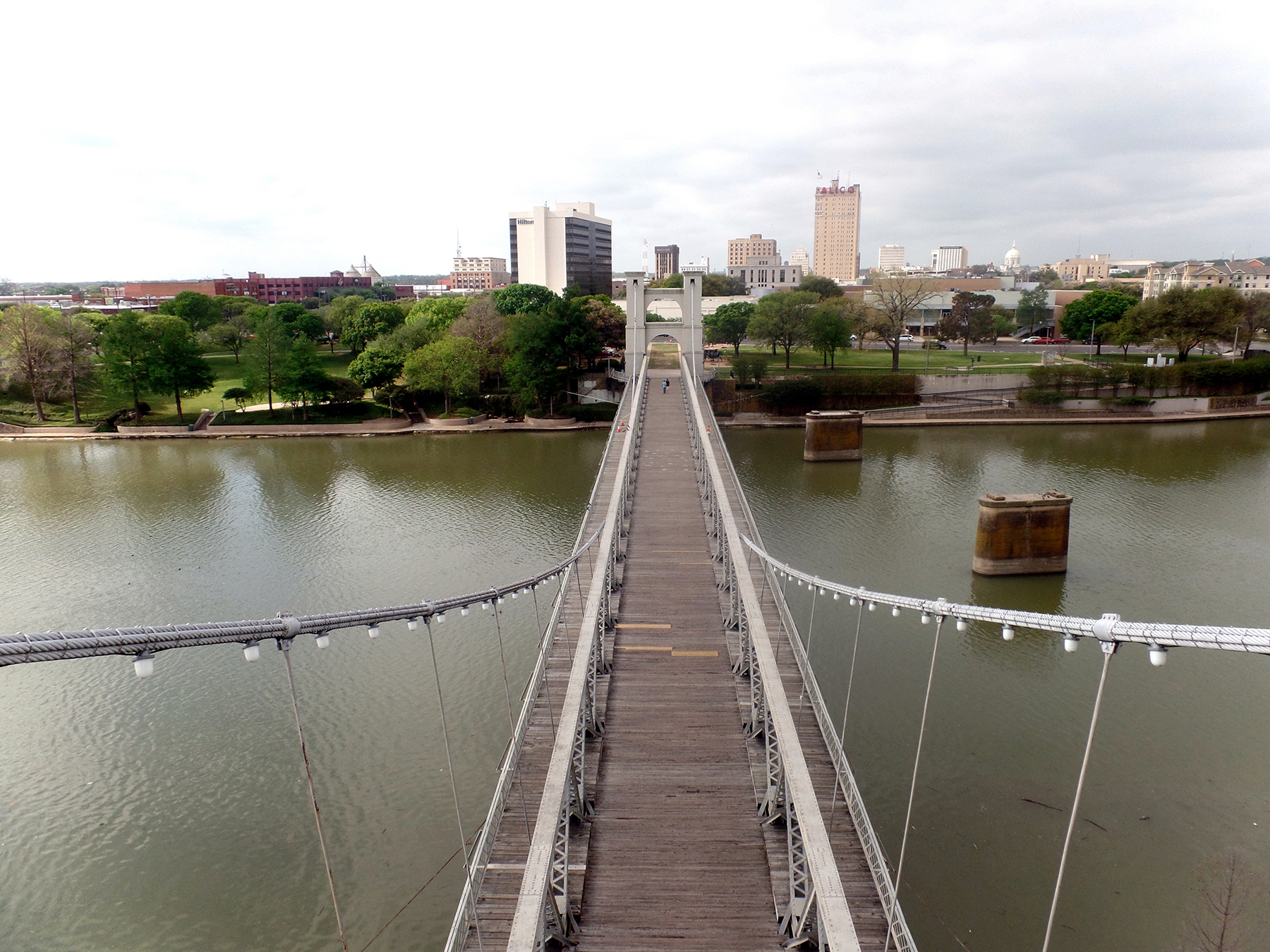
In the end, Structural Technologies chose to release the hangers — one by one or in pairs — connecting the suspension cable to the deck in a carefully designed sequence to prevent overstressing any part of the bridge. “As you start releasing the hangers, the stiffening truss is sitting on these temporary supports, and the cables start changing shape and rising,” Stuffle says. “If you do it without thinking about the sequence, you can end up with one of the existing hangers taking too much load.” This could have damaged the hangers or the existing cable clamps, which were being reused, he explains.
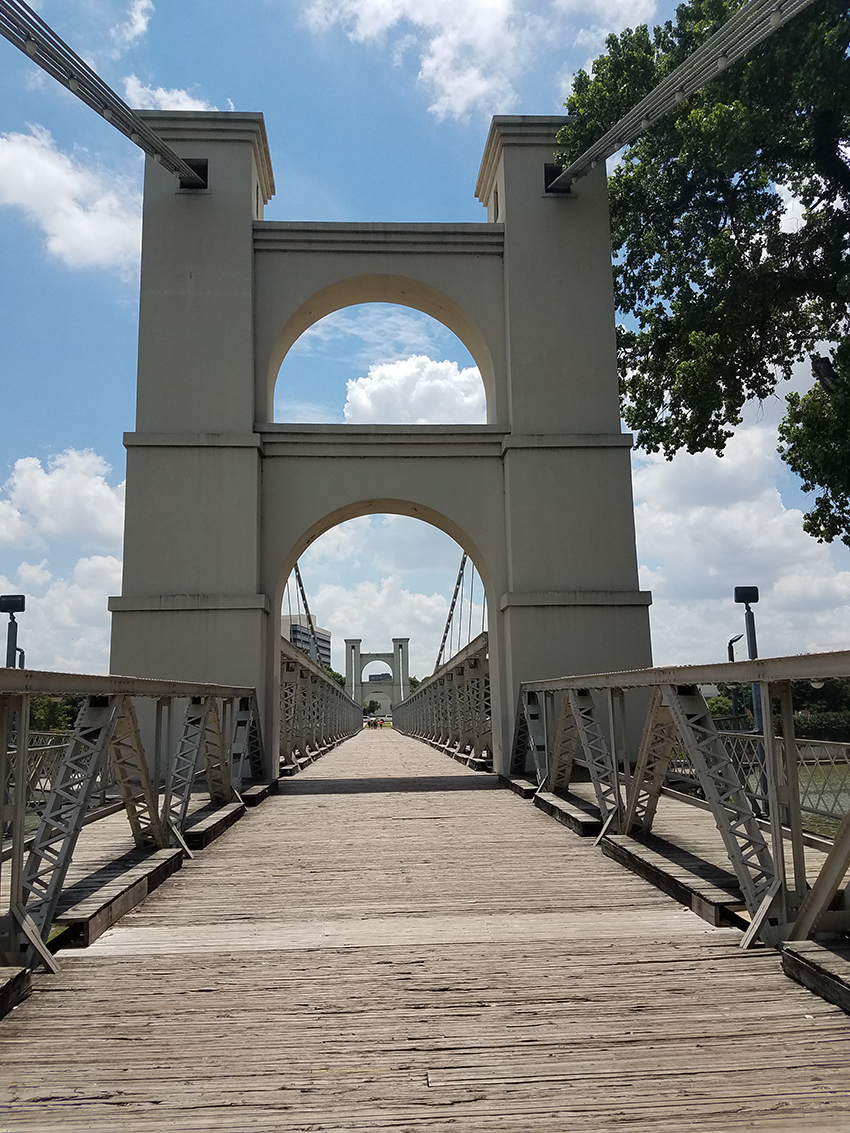
The work began in January 2021. Hydraulic jacks under the bridge deck were used to take the load off the hangers. Then the hangers were removed in a coordinated sequence: two or three in a row, then a pair would be skipped, then two or three more would be removed as the work progressed from the ends of the bridge to the center and back out again. They were left with several pairs of hangers spaced along the length of the bridge that they de-tensioned simultaneously. At the final three locations, the hangers were reinforced with supplemental tie-downs because the predicted force exceeded the capacity of the existing hangers. In all, removing the bridge’s sway cables, hangers, and suspension cables took about two months.
Reinstallation
Meanwhile, the bridge’s timber deck, parts of which were rotting, is being replaced with a new, thin concrete deck poured on top of fiber reinforced polymer stay-in-place structural formwork. New hardwood decking will be laid at the sides of the deck in a nod to the bridge’s historic character. According to Nick Welch, the vice president of Gibson & Associates, Inc., the masonry of the bridge’s anchor houses and bridge towers will be rehabilitated: Masonry will be repointed as needed, new plaster will be added as needed, and new tie rods will be installed through the existing towers and anchor house walls to reinforce the existing masonry structures.
Beginning in December, Structural Technologies will start the reinstall of the suspension cable and new hangers. That should take about three months.
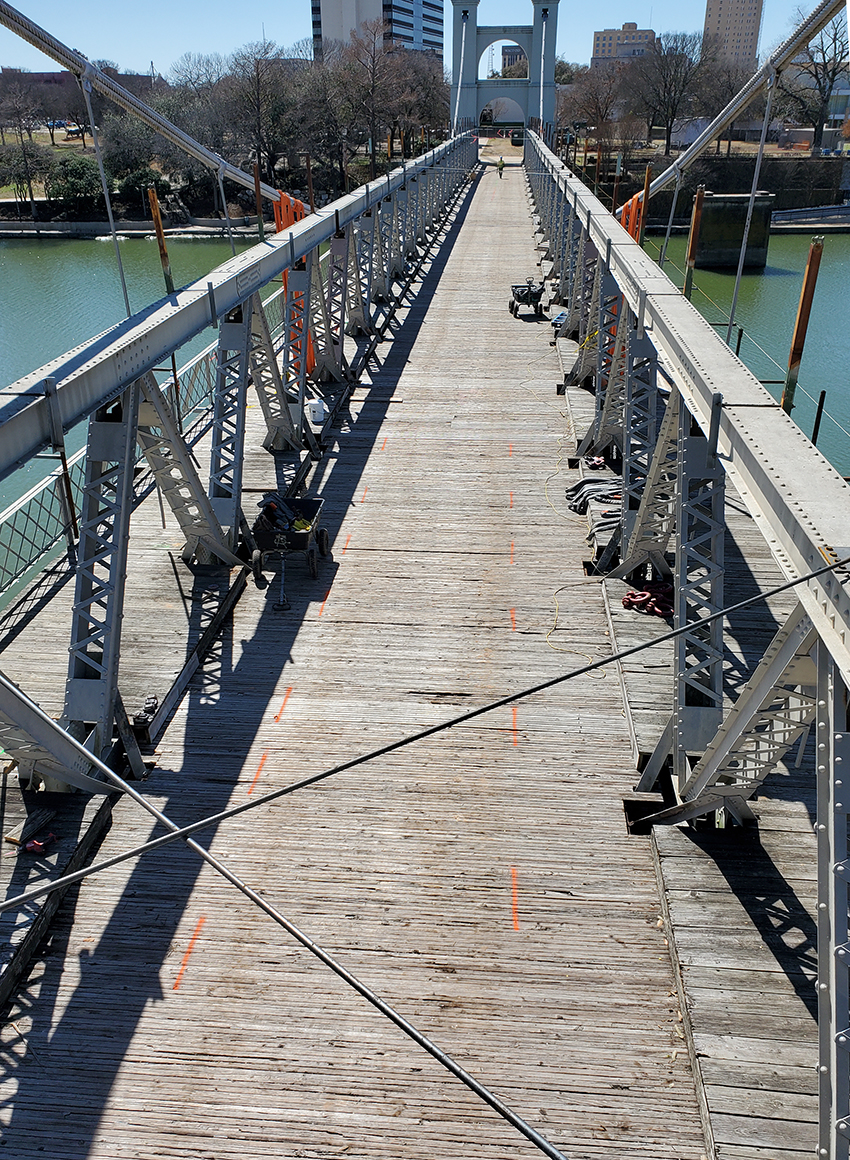
The hangers will be reinstalled with the same care given to proper sequencing as was their removal, according to Campbell. Two winches and a specially designed frame with rollers, which will cantilever off the tower footprint, will thread the cables through the suspension housing.
For reconstruction, the hangers are being manufactured several feet longer than is necessary for their final condition. This is so they are long enough to pull into position, and then they will be cut to the right length. “That gives you enough room to put a jacking chair and a hydraulic jack underneath the floor beam to pull the hangers to the correct length and adjust them to the right tension,” says Stuffle.
The new suspension cables will enter the existing anchor houses and connect to a new anchor block system that will be positioned underneath and behind the anchor houses.
Rehabilitation of the existing suspension bridge is on schedule to be completed in 2022. "We were told during the preliminary stages of this project that the suspension bridge is one of the top attractions in Waco,” says Welch. “It's a staple to the community. And we're excited to do our part to help preserve a piece of history.”
“Since the Waco Suspension Bridge’s initial construction, it has served as a central landmark of the Waco community, taking on a cultural identity of its own that has sustained through generations of ever-changing surroundings and uses,” says Tom Balk, the program manager for the City of Waco Parks and Recreation Department. “At its essence, it remains a celebrated connection that joins our city together, representing the idea that Waco’s strength and vitality continue to be driven by the connectivity and unity of its communities. With iconic structures like this, it’s important to consider that each generation has done its part to ensure the legacy is preserved intact for the next — and in this case the Waco community has really come together to embrace this important work so that it can live on for generations to come.”
This article has been revised to more accurately reflect each company’s role in the project, with quotes added from the engineer of record and the client.


